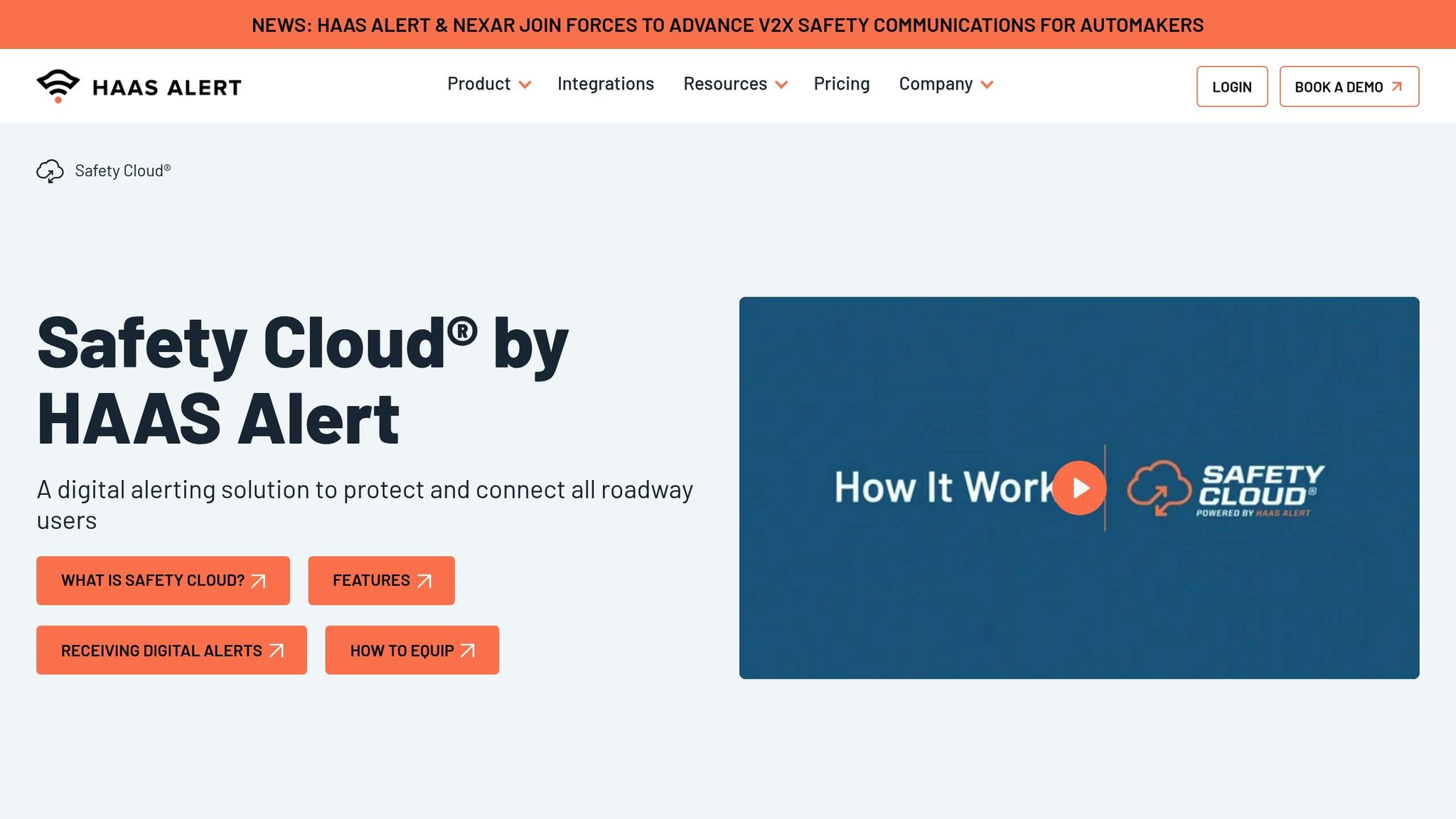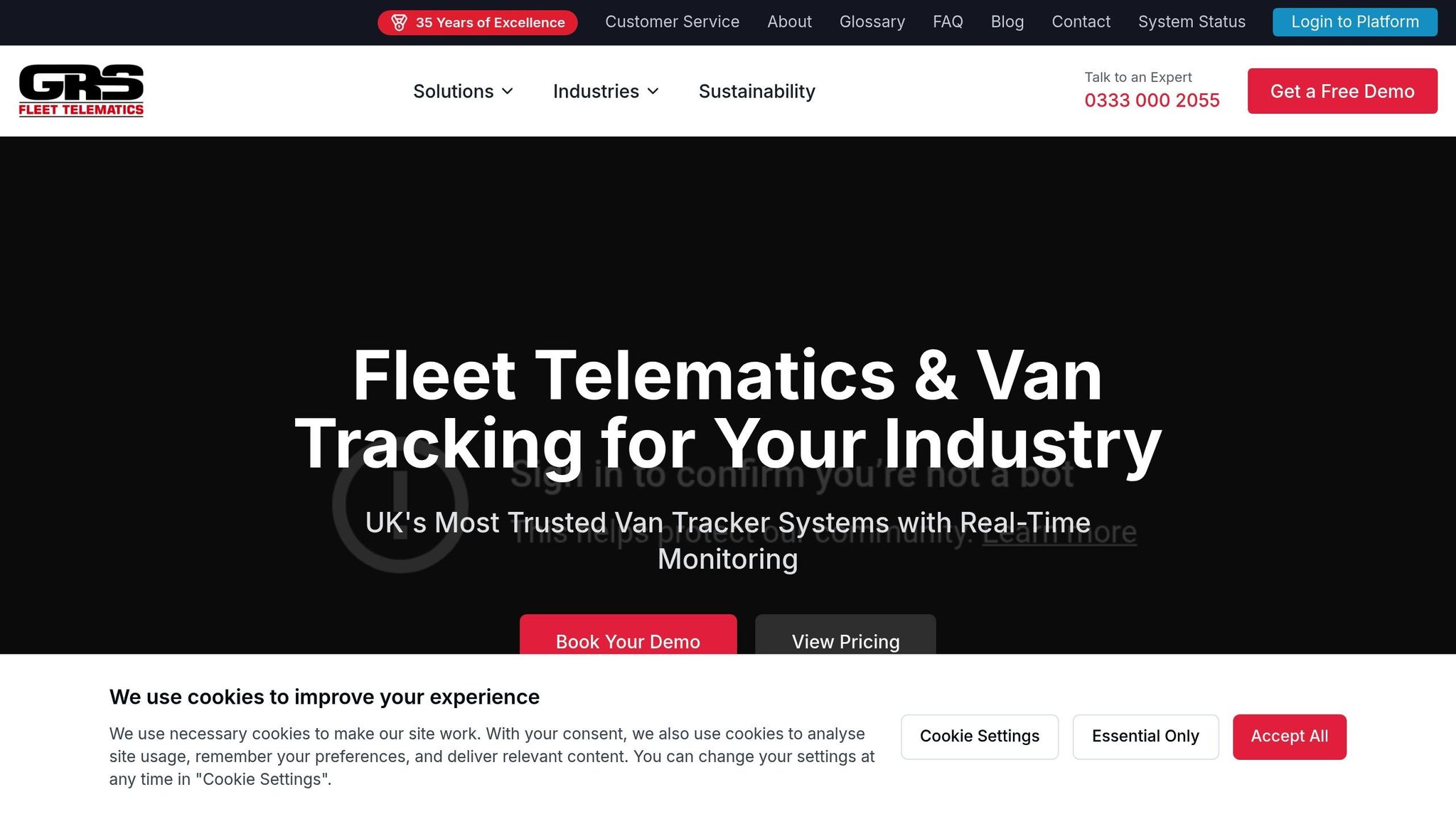How Digital Alerts Reduce Emergency Response Times
Explore how digital alert systems are revolutionising emergency response in the UK, enhancing safety, efficiency, and reducing response times.

When seconds matter, digital alert systems are transforming emergency response in the UK. By sending real-time notifications to drivers near emergency vehicles, these systems help clear routes faster, reduce collisions, and save lives. Here’s what you need to know:
- Traffic congestion and driver awareness: Alerts prompt drivers to move aside, improving compliance with Move Over laws and reducing gridlock.
- Communication breakdowns: Modern platforms integrate with fleet telematics for seamless coordination and instant updates.
- Key benefits: Emergency response times drop by up to 73 seconds, collision rates fall by 40%, and operational costs decrease significantly.
For UK fleets, adopting digital alert systems not only improves safety but also enhances efficiency and lowers expenses, making them an essential upgrade for today’s roads.
Safety Cloud® by HAAS Alert: How it Works

The Problem: What Slows Down Emergency Response
Despite advancements in technology, emergency response times in the UK still face significant hurdles. These delays not only put first responders at risk but also challenge fleet managers striving to ensure both driver safety and operational efficiency during critical moments.
Traffic Congestion and Driver Awareness Challenges
Traffic congestion continues to be the most significant obstacle for emergency responders in the UK. According to research, 41.7% of first responder agencies identify congestion as their primary issue when trying to reduce response times. Even with flashing lights and blaring sirens, emergency vehicles often find themselves stuck in gridlocked streets.
Fire Commissioner Laura Kavanagh voiced this frustration clearly:
"There are some places where there's so much traffic you can't even go around it, it doesn't matter if you have lights and sirens, it's just gridlock"
Adding to the problem, many drivers fail to yield properly to emergency vehicles. Alarmingly, 80.5% of first responders have raised serious concerns about safety at intersections. This becomes even more critical when considering that every minute without CPR or defibrillation reduces a person's chance of survival by 7–10%. Unpredictable driver behaviour, stemming from a lack of awareness, not only delays emergency responses but also increases the risks for responders and other road users.
These physical roadblocks are further compounded by issues in communication during emergencies.
Communication Failures During Emergencies
Outdated communication systems represent another major hurdle for emergency response teams. Coordinating effectively between fleet vehicles, emergency services, dispatchers, and drivers is vital in high-pressure situations. Yet, studies show that 86% of senior executives, managers, and junior staff experience communication breakdowns that hinder productivity and lead to missed objectives.
Monique Zytnik, a Communication Specialist at Zytnik Consulting, highlights the complexity of this issue:
"Internal communicators need to be in tune with their people and places, working closely with HR, health and safety policy teams, and senior leaders to communicate clearly with staff. Everyone has been affected in different ways, and we know that things are far from being stable"
These communication lapses can have serious consequences. For example, it can take drivers up to 20 minutes to respond to dispatcher messages. In emergencies, such delays can escalate minor incidents into full-blown crises.
Impact on Safety and Fleet Operations
Delayed response times don’t just threaten lives - they also have a ripple effect on fleet operations. The risks of injury, vehicle damage, and prolonged road closures disrupt schedules, hurt customer satisfaction, and inflate operational costs.
Moreover, these delays and communication failures contribute to driver fatigue and stress, which are significant safety concerns. Each year, over 6,000 truck crashes and nearly 800 fatalities are linked to these issues. The reliance on outdated tools like mobile phones, radios, and manual coordination is simply no match for the demands of modern fleet operations, especially on the UK's increasingly congested roads.
The Solution: How Digital Alerts Speed Up Emergency Response
Modern digital alerting platforms are transforming emergency response by addressing critical communication and coordination challenges. These systems create a connected network where emergency services, fleet managers, and drivers can work together in real time, shaving off precious seconds when they are needed most.
How Digital Emergency Alerting Platforms Work
These platforms rely on a combination of multi-channel communication and geo-targeting to ensure vital information reaches the right people instantly. When an emergency vehicle activates its lights, the system springs into action, sending alerts via SMS, email, mobile apps, and voice calls to ensure comprehensive coverage.
Geo-targeting focuses these alerts on drivers within a specific radius of an emergency vehicle, prompting them to slow down and move over. Meanwhile, drivers outside the affected area remain undisturbed, avoiding unnecessary distractions.
Marc Jaromin, Director of Public Safety Platforms at Futuri, highlights the value of AI in these systems:
"AI is a tool, and it allows emergency managers to focus in on what they want to focus in on. They've got to get the right information out at the right time to the right people. Let the system do the work, and that's what AI does. That's the art of artificial intelligence."
Drivers receive up to 30 seconds' warning to adjust their behaviour, which significantly increases compliance with Move Over laws. These systems also provide real-time data, such as weather conditions, incident updates, and location tracking, allowing emergency teams to make better decisions under pressure.
A standout feature is the independent cloud infrastructure used by some platforms, like Crises Control. Unlike systems reliant on major providers such as Microsoft, these platforms remain operational even when traditional networks fail - an essential capability given the fivefold increase in weather-related disasters over the past 50 years.
This real-time alerting capability also integrates seamlessly with fleet telematics systems, further enhancing safety and efficiency.
Working with Fleet Telematics Systems
Digital alert platforms integrate directly with fleet telematics systems, creating a smooth safety network for emergency responders and commercial fleets alike. The best part? No additional hardware is required, making it an easy upgrade for businesses already using telematics solutions.
This integration supports real-time location sharing between emergency vehicles and fleet systems, eliminating guesswork and providing drivers with timely updates. For instance, the Columbus Fire Department saw a 15% reduction in struck-by collisions and improved response times after adopting digital alerts in spring 2023.
Additionally, these systems play a key role in reducing collisions between emergency vehicles responding to the same incident. Research from HAAS Alert and the US National Highway Traffic Safety Administration shows that 95% of first responders slow down when notified about other responding units in the area.
Two-way communication ensures that alerts are received, enabling fleet managers to coordinate responses more effectively and minimise miscommunication during critical moments. Integration with HR databases and intelligence feeds further refines the process, ensuring that alerts reach the right personnel based on their role, location, and duties. This targeted approach avoids information overload while keeping all key players informed during emergencies.
Main Benefits of Digital Alerts for Fleets
Digital alerting systems bring noticeable improvements to fleet operations, enhancing safety, cutting response times, and lowering costs. Here's a closer look at what these systems offer.
Faster and Safer Route Clearance
Digital alerts make emergency vehicle navigation more efficient by notifying nearby drivers to move aside. When emergency lights are activated, these alerts are sent to smartphones, navigation systems, and in-vehicle displays, providing real-time warnings. This technology significantly reduces collision risks - by as much as 90% compared to relying on traditional lights and sirens alone. Additionally, vehicles equipped with digital alerts see an 80% drop in hard braking incidents.
Paul Jodoin, EDC-6 NextGen TIM Co-Leader, highlights how this technology enhances safety:
"Aware drivers are potentially safer drivers when passing roadway incidents, work zones, and responders. Next-generation TIM technology like digital alerts is proving to be a great way to help create better awareness among road users."
The state of Pennsylvania offers a compelling example of these benefits. After introducing an emergency vehicle alert system, crashes involving roadside agency vehicles dropped from 30 in 2018 to zero in 2020.
Shorter Response Times and Lower Costs
Quicker route clearance doesn't just save lives - it saves time and money too. The Columbus Fire Department, for instance, shaved an average of 7 seconds off response times, with some vehicles saving as much as 73 seconds. These time reductions translate into lower fuel consumption and reduced wear and tear on vehicles. Fleets that implement safety monitoring systems also report a 40% decrease in collision rates. With the average annual cost of crashes for a commercial fleet sitting at around £55,000, such improvements can lead to significant financial savings.
Improved Safety and Environmental Impact
Digital alerts also help reduce roadside incidents. The Columbus Fire Department saw a 15% decrease in struck-by incidents after adopting these systems.
Beyond safety, there are environmental advantages. By enabling smoother traffic flow and reducing stop-and-start driving, digital alerts help cut down on unnecessary idling and lower emissions.
Mike Malinowski, a service technician with AAA Roadside Assistance, offers a stark reminder of the dangers faced by roadside workers:
"You never realise how fast vehicles are moving until you're not moving and everyone is doing 70 or 80 mph around you."
Using Digital Alerts with GRS Fleet Telematics

GRS Fleet Telematics combines cutting-edge tracking technology with digital alert systems to improve fleet response across the UK. This integration enables better coordination and safety for fleet operations.
Advanced Tracking and Security Features
GRS Fleet Telematics provides real-time tracking that integrates seamlessly with platforms like HAAS Alert's Safety Cloud. This setup not only allows fleet operators to track vehicle locations but also sends alerts to nearby drivers during emergencies. The system’s dual-tracker technology ensures uninterrupted monitoring, even if the main system fails. Additionally, driver behaviour monitoring tracks speed, geofencing, and eco-driving analytics, offering valuable insights for improving safety. Over time, this data helps fleet managers identify patterns and implement better safety measures. When paired with warning lights via HA-7 transponders, the system creates a robust safety network that goes beyond standard emergency response systems.
A prime example of these features in action is GRS Group's operation of the UK’s largest fleet of Mercedes-Benz Econic trucks, which are equipped with Samsara telematics. These vehicles, used on HS2 construction projects in Central London, include Active Brake Assist 5 emergency braking technology for enhanced safety.
Matthew Johansson, Plant and Logistics Director at GRS Group, explains their commitment to safety:
"Our decision to invest so heavily in the Mercedes‑Benz Econic was driven by a desire to go beyond minimum requirements and set the highest possible standards for safety, while at the same time future‑proofing our fleet against any tighter future restrictions."
These features enable smoother, safer, and more efficient operations for UK fleets.
How It Works with UK Fleet Systems
GRS Fleet Telematics integrates easily with existing UK fleet management systems, creating a unified platform for emergency response. Its real-time tracking identifies the closest available vehicle to an incident, ensuring faster dispatch times. This capability is especially useful for public sector and emergency services, where quick response is critical.
The platform’s compatibility with existing systems means organisations can enhance fleet management and resource allocation without needing to overhaul their current setup. Fleet managers can oversee multiple vehicles at once, ensuring efficient coordination and optimal resource use during emergencies.
For organisations with large fleets, the benefits are tangible. Helen Morris, Fleet Manager at Westshire Housing Association, shares her experience:
"Managing a fleet of 75 service vans across 5,000 properties requires precise tracking and coordination. GRS Fleet Telematics' van tracking solution has transformed our operations, improving maintenance response times by 22% while significantly reducing fuel costs."
Custom Solutions for UK Businesses
GRS Fleet Telematics recognises that businesses have varying emergency response needs. The platform offers customisation options tailored to specific industries, improving response times and safety. Businesses can even opt for white-label branding, aligning the platform with their corporate identity.
The system boasts an impressive 91% vehicle recovery rate [41, 44], making it a reliable choice for critical situations. With affordable pricing, it’s accessible to businesses of all sizes. Hardware packages start at £35, with a monthly service fee of £7.99 per vehicle. There are three hardware tiers to suit different needs:
- Essential (£35): Single wired tracking for cost-effective monitoring.
- Enhanced (£79): Adds Bluetooth backup for better theft protection.
- Ultimate (£99): Includes immobilisation for maximum security.
Free installation is available when combined with fleet branding services, simplifying the implementation process for businesses.
The platform’s driver behaviour monitoring not only reduces risks but also provides data that supports insurance claims and compliance with regulations. By focusing on both prevention and rapid response, GRS Fleet Telematics helps businesses operate more safely and efficiently.
Conclusion: Using Digital Alerts for Better Emergency Response
Digital alerts and telematics are reshaping how UK fleets respond to emergencies, enhancing safety, operational efficiency, and cost management. For instance, the Columbus Fire Department saw a notable drop in collisions after adopting digital alerting systems. Research also highlights improved coordination among first responders when they are promptly notified about nearby emergency vehicles. These findings offer a glimpse into the practical advantages of these technologies.
Take Severn Trent Services as an example. Their integrated telematics system automatically detected a crash in rural Kent, pinpointed the location with GPS coordinates, and alerted emergency services. Additionally, they managed to cut engine idling by 30% between December 2023 and December 2024.
The benefits extend across sectors. Steve Thompson, head of transport at West Yorkshire Police, shared his perspective on the value of telematics:
"The introduction of telematics has proved very positive for West Yorkshire Police with no downside. We have had a lot of interest from other police forces and I believe more constabularies will equip vehicles with telematics devices."
GRS Fleet Telematics exemplifies how these advancements come together. Their solution integrates real-time tracking, dual-tracker technology, and digital alerts, achieving a 91% vehicle recovery rate. Starting at just £7.99 per month, this system allows UK businesses to enhance emergency response capabilities without the need for major system overhauls. Features like automatic crash detection and 24/7 support provide fleets with the safety measures they need in today’s fast-paced environment.
The long-term benefits are clear. Telematics can lower fuel costs by up to 15% while encouraging safer driving habits. For example, fleets have reported a 20% drop in distracted driving, a 9% reduction in hard braking incidents, and 27% less time spent speeding. For UK businesses handling critical operations, these improvements mean quicker response times, lower expenses, and safer roads for everyone.
With the vehicle telematics market projected to reach £136 billion by 2032, it’s evident that early adopters are already seeing significant returns. For businesses, integrating digital alerts and telematics isn’t just an option - it’s a step towards staying ahead in a rapidly evolving landscape.
FAQs
How do digital alert systems help reduce emergency response times?
Digital alert systems are a game-changer when it comes to cutting down emergency response times. With instant communication and real-time information sharing, these systems make sure critical updates reach emergency responders within seconds. This means they can act fast and effectively in situations where every moment counts.
By automating the alert process and connecting through multiple communication channels, these systems ensure the right people are notified without delay. This quick flow of information allows for smarter decisions and faster resource deployment - both of which are crucial in emergencies.
For businesses managing vehicle fleets, tools like GRS Fleet Telematics take efficiency to the next level. With features such as dual-tracker technology and live location updates, they help recover stolen vehicles quickly and improve overall safety - all starting at just £7.99 per month.
What challenges do emergency responders face, and how do digital alerts help overcome them?
Emergency responders often grapple with serious obstacles like delayed communication. Traditional systems often depend on manual input or third-party reports, which can slow the flow of crucial information. Another major hurdle is the absence of real-time updates, making it harder to maintain situational awareness and make quick decisions in rapidly changing emergencies. These delays can significantly affect how swiftly and efficiently teams can act.
Digital alert systems step in to tackle these challenges by providing instant notifications and real-time updates. This ensures responders get accurate information exactly when they need it. With better communication, teams can coordinate more effectively, cut down response times, and improve overall emergency outcomes.
How do digital alert systems work with fleet telematics to improve emergency response times?
Digital alert systems work hand in hand with fleet telematics to enhance emergency response times by sending real-time updates to drivers about nearby hazards or approaching emergency vehicles. Through vehicle-to-everything (V2X) communication, drivers receive crucial information that helps them adjust their actions - whether it’s slowing down or making way - ensuring safer roads and smoother emergency operations.
These systems also equip fleet managers with essential data, including vehicle locations, alert statuses, and records of past incidents. This information allows for better coordination, especially in high-pressure scenarios. By tapping into advanced tools like AI and predictive analytics, digital alerts enable emergency vehicles to navigate traffic more efficiently, cutting delays and potentially saving lives.
